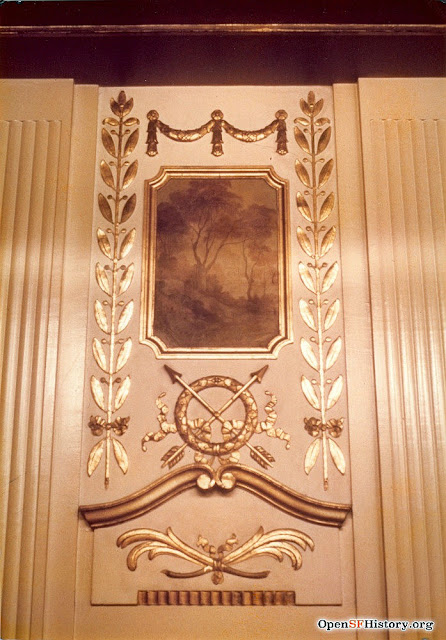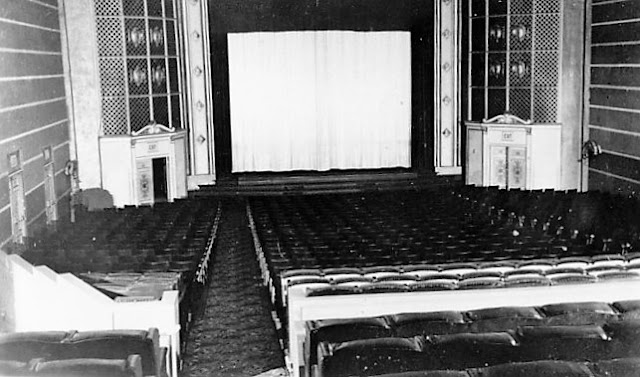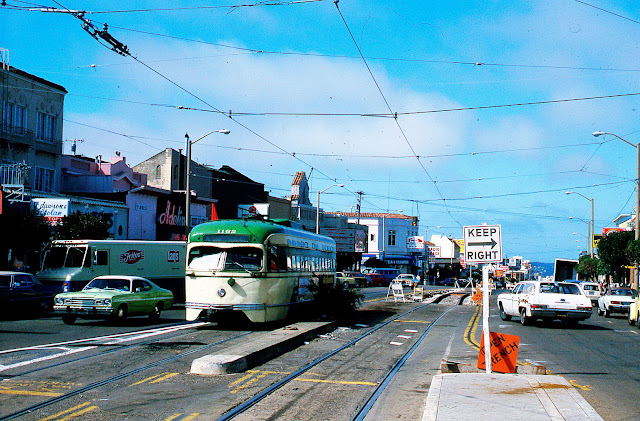85 West Portal Ave. | map |
News: The lobby began to be used as a Jewish Chabad center in 2023. See links to several news stories lower on the page.
Opening: It opened as the
Portal Theatre on December 26, 1925. The pre-opening photo is from the
San Francisco Public Library collection. A version of the photo is also on the website of the
Open SF History Project.
Architect: It was designed by local architect Irving Morrow of the firm of Morrow & Garren for Hyman S. Levin. The project was originally envisioned with an open courtyard in front of the theatre's entrance. A set of plans for the project are in the Gary Parks collection. See nine details from these at the bottom of the page.
A 1923 drawing of architect Irving Morrow's vision for the complex from the Irving F. and Gertrude Comfort Morrow Collection, Environmental Design Archives, UC Berkeley. It appears on the Western Neighborhoods page about the theatre. Gary Parks comments: "I have blueprints for the Portal (Empire), and, while the interior was
built as drawn, the facade was drawn much differently than what was
built--with a Mission style tower, featuring several arches--each with a
bell it it."
Seating: Original capacity was about 900. The remodel in the
early 40s increased the theatre's capacity to 1,075 seats. After the 1974
triplexing it ending up with a capacity of 605 with a breakdown of 295,
158 and 152.
The theatre was renamed the Empire on October 1, 1936. Thanks to Mike Rivest for locating this ad from the day of the reopening. A remodel in the early 40s resulted in a 200 seat increase in the theatre's capacity.
The theatre got a remodel by the Levin family in 1970. Thanks to TJ Fisher for locating this May 13 reopening ad that appeared in the Examiner. It was part of a post on the
BAHT Facebook page. He notes that the reopening was "after a closure of several months during which paintings and other ornamentation were replaced with the mirrored lobby we see today. It was no doubt truly modernized, but in my opinion it was sterilized too: the result has very little character. At least the seats were more comfortable..."
A directory ad located by TJ that also appeared May 13, 1970. He cites "
And in the End," an August 2020 Rolling Stone article by Rob Sheffield that mentions John Lennon and Yoko Ono catching "Let It Be" unnoticed in a nearly empty theatre in San Francisco. Presumably the theatre was the
Alhambra on Polk St., where the film had also opened May 13:
"John and Yoko finally saw it in an empty movie theater in San Francisco in June 1970, along with Rolling Stone founder Jann S. Wenner and his wife, Jane. The four of them bought their tickets at the door and sat unnoticed in the afternoon matinee. 'Just bought tickets and went in,' Wenner recalled years later. 'I don’t think anybody even really knew we were there. It was empty, afternoon, and during a weekday. So the four of us are sitting together in the middle of the theater, watching this thing about the breakup of the Beatles.' John couldn’t hide his tears. 'I just remember walking out of the theater and all of us in a foursome huddle, hugging, and the sadness of the occasion.'"
TJ adds: "'Let It Be' left San Francisco proper after May 26th and did not return until July 1st, so it seems John and Yoko cannot have seen it there in June. Maybe they saw it out of town in June, or maybe they saw it in the city in May or July." See his post for details about various area bookings of the film.
Ray Syufy's Century Theatres acquired it from the Levin family in March 1974 and triplexed it with a reopening on June 26, 1974 as the Empire 3. Thanks to Mike Rivest for finding the opening day ad. Two small
screens were added in the back corners of the upper seating area of the stadium-style house. The three screens use a common booth. Century was later bought out by Cinemark.
Since 2003 it's been called the CinéArts at the Empire. Thanks to Mike Rivest for locating the September 12, 2003 ad.
Closing: The theatre closed March 16, 2020 as a result of the Covid
shutdown. Cinemark later decided to not renew their lease and in
February 2021 listed the theatre on their website as "permanently
closed." See "Historic West Portal Theater Closes...,"
a February 10 story by MJ Johnson on the KQED website. Thanks to
William David French, Jr. and TJ Fisher for sharing the news on a post
on the BAHT Facebook page.
J.K. Dineen had an update with his October 2021 Chronicle story "The Empire Theater went dark during the pandemic. A new owner wants to revive the West Portal hub." Thanks to Adam Paramore for spotting the news. The building was owned at the time of the closing by the Appleton family. Family member Jesse Appleton, along with a brother and a friend as
partners, bought the building from other family members.
Status: The lobby is now used, at least temporarily, as a Jewish community center. This new use for the building was celebrated in "Chabad brings new life to S.F cinema with a Jewish backstory," a March 2023 story in The Jewish News of Northern California. Thanks to Steve Rhodes for spotting the article.
Lobby views:
A November 1944 lobby photo taken by Ted Newman. It's from the Jack Tillmany collection and appears on the
San Francisco Public Library website.
A view of a lobby wall panel taken in early 1970 by Steve Levin before the theatre closed for a
"modernization." The photo is now in the Jack Tillmany collection and makes an appearance on the
Open SF History Project website.
The lobby in 2019. Thanks to Terry Wade for the photo, one of many he took that appear on the
Cinema Treasures page about the theatre.
Looking into the lobby of the closed theatre in June 2021. Thanks to TJ Fisher for this photo and the two below. They appeared in a post on the
BAHT Facebook page.
Entrance doors to two of the auditoria. Photo: TJ Fisher - June 2021. He comments: "While I'm sure it's not costing a lot of money to run the displays above the entrances to the three screens, we were tickled to note that someone went to the trouble of programming 'CLOSED' there in lieu of any other posted message."
The snackbar. Photo: TJ Fisher - June 2021. Thanks, TJ!
The auditorium:
The house right organ grille area before the December 1925 opening. Note the mess over near the steps. It's a Jack Tillmany collection photo on the
Open SF History Project site.
The rear of the house in December 1925. It's a photo from the Jack Tillmany collection on the
Open SF History Project site.
A November 1944 auditorium photo by Ted Newman from the Jack Tillmany collection. It appears on the
San Francisco Public Library website.
A 1950s photo from the Jack Tillmany colection appearing on the
Open SF History Project site. Note the re-do of the organ grille areas.
A 1969 photo from the collection of the late Steve Levin that's now in the Jack Tillmany collection. It's on the
Open SF History Project website. The auditorium became a drab box with a 1970 remodel.
A look along the crossaisle toward the lobby. To the left, what had been the upper stadium-style seating section is now walled off as Cinemas 2 and 3. Thanks to Terry Wade for the 2019 photo on
Cinema Treasures.
A screen view of the big house. Thanks to Adam Martin for his 2005 photo on the
Cinema Tour page about the theatre where you'll find many more shots he took.
The rear of the auditorium downstairs. The three theatres use a common projection booth. Photo: Adam Martin -
Cinema Tour - 2005
Looking toward the screen in the house right auditorium upstairs. The other upstairs house is similar. The strange ceiling structure on the left is part of the tunnel for the
beam from the common projection booth to reach the main theatre
downstairs. Photo: Terry Wade -
Cinema Treasures - 2019
The rear of the house right auditorium upstairs. Photo: Terry Wade -
Cinema Treasures - 2019. Thanks, Terry!
A pre-DCP look at the three machine booth with Century projectors, Xetron xenon lamp consoles and Christie Autowind platter systems. Photo: Adam Martin -
Cinema Tour - 2005
One of the Century machines that used to be in the booth, with a Dolby Digital soundhead on top. Photo: Adam Martin -
Cinema Tour - 2005. Thanks, Adam!
A January 20, 1927 photo by Horace Chaffee for the Department of Water and Power. It appears on the
Open SF History Project website.
Jesse Levin, the theatre's first house manager, out in front in 1928. They're advertising Douglas Fairbanks in "The Gaucho" and Bebe Daniels in "Feel My Pulse." It's a photo from the Jack Tillmany collection appearing on the
Open SF History Project website. Thanks to Jack for the research concerning Mr. Levin.
A detail from Jack's c.1929 photo. They're playing the Clara Bow film "The Wild Party."
New name, new marquee. Thanks to Jack Tillmany for locating this one for a post on the
BAHT Facebook page. He comments: "
A photo taken soon after its reopening as the Empire - October 1936."
"Two Outstanding Hits - The Pick of The Major Studios - Only the Big Pictures..." It's a November 1944 Ted Newman photo in the Jack Tillmany collection. It makes an appearance on the
San Francisco Public Library website.
Another November 1944 photo by Ted Newman from the Jack Tillmany collection. It's on the
San Francisco Public Library website. Jack notes that film titles weren't put on the marquee since with wartime lighting restrictions it couldn't be turned on at night anyway.
A December 1947 photo from the Jack Tillmany collection.
A 1956 look west with the theatre running "Carousel" with Gordon McRae and Shirley Jones along with "The Man Who Never Was," a February release starring Clifton Webb and Gloria Grahame. "Carousel" played five weeks at the Fox earlier in the year. Thanks to Sean Ault for sharing the photo from his collection.
A 1956 view appearing on the
Open SF History Project site courtesy of a private collector. "Back From Eternity" was a September release.
A 1965 look east with the theatre over there on the right. The photo appears on the
Open SF History Project site courtesy of a private collector.
A 1966 photo from the Jack Tillmany collection.
"Wait Until Dark" and "Cool Hand Like" playing in May 1968. It's a photo by Tom Gray that's in the Jack Tillmany collection. Thanks to Jack for sharing the photo as a post on the
BAHT Facebook page.
A detail from the May 1968 photo.
An early 1970 photo taken by Steve Levin before the theatre closed for a "modernization." The photo is now in the Jack Tillmany collection.
A boxoffice view from the Gary Parks collection. He comments: "Here is an image from a slide given to me by the late Steve Levin, whose family once owned the Empire. Steve, as a very young man, took this, and other slides of the marquee and entry of the Empire, when he knew it was going to be remodeled. He told me that, later, his father regretted doing the 1970 remodel, from an aesthetic sense--though not from a patron traffic flow sense--as the remodel of the lobby areas remedied some crowd control issues. But, as Steve himself said, the interior remodel left the auditorium 'a charmless, draped box.'" Gary posted the photo on the
BAHT Facrebook page.
Looking west c.1970 with the theatre down
there on the left
under the 66 billboard. Thanks to Avery Lieberman for posting the photo on
San Francisco Remembered. The marquee looks blank -- maybe the photo dates from the time of the 1970 renovation. The triplexing didn't happen until 1974.
"Let It Be" and "The Producers" in May 1970. It's a photo by Tom Gray that's in the Jack Tillmany collection. TJ Fisher comments: "This was their grand reopening bill on May 13. Orchids for the ladies and another gift for the men on that first night! It ran two weeks."
"Patton" playing in August 1970. It's a photo by Tom Gray that's in the Jack Tillmany collection. Jack comments: "That vintage streetcar is Muni's venerable, historic Car #1 which launched the Muni system back in 1912, out on one of its frequent and popular fan trips."
"Fiddler On The Roof" in June 1973. It's a photo by Tom Gray that's in the Jack Tillmany collection.
The new marquee treatment following the tripexing in 1974. It's a photo by Tom Gray that's in the Jack Tillmany collection.
A c.1975 view toward the triplexed theatre. Thanks to Sean Ault for sharing this photo from his collection.
A November 1976 view with "The Omen" among the films playing. It's a photo by Tom Gray that's in the Jack Tillmany collection.
A 1979 view toward the theatre from the Sean Ault collection. "The Exorcist" was playing on screen 1. Thanks, Sean!
Kevin Walsh advises that these LRVs were delivered in 1979-80 although the tunnel work had been completed in 1978. TJ Fisher comments: "1979 is correct. The Regency II had it exclusively for three weeks in April, then it moved to the Empire, St. Francis, Serramonte Plaza Twin, and Geneva Drive-In on the 25th. That lasted two weeks."
A
Christmas season view c.1979 affording us a view of the screen end of
the building above the rear of the train. Thanks to Sean Ault for
sharing this photo from his collection.
"Carbon Copy," a September 1981 release, was one of the titles on screen 1. Thanks to Sean Ault for sharing this photo from his collection.
A 2013 view of the theatre from San Francisco Realtors. It appeared on the now-vanished blog Up/Out.
The closed theatre in June 2021. Thanks to TJ Fisher for this photo and the two below. They appeared in a post on the
BAHT Facebook page.
A look across the entrance. Photo: TJ Fisher - June 2021
The dead boxoffice. Photo: TJ Fisher - June 2021. Thanks, TJ!
A March 2023 shot by taken by Gary Parks. As he noted in his post on the
BAHT Facebook page, it was "looking a little sad."
Details from the plans for the theatre in the Gary Parks collection:
A title block from one of the sheets.
A facade elevation.
A section though the lobby and auditorium. It's a stadium-style house. On the left we're looking into the upper stadium-style section from the crossaisle. On the right note the bells in the openings in the tower of the facade.
Gary
comments: "It amazes me how simple and cheap this theatre was, as
originally planned. The exterior ended up being larger and more ornate.
Later, General Theatrical—the Ben Levin branch of the Levin
family—added seating to the theatre by building out the rear of the
auditorium to the sidewalk, without, according to Steve Levin, having to
close the theatre. He said the remodel more than paid for itself
within a very short time. At that time, the auditorium got a
redecoration in the form of murals, and the lobby got a 'Modern Empire'
style redecoration in the form of dignified plaster relief work and some
mural vignettes.
"When
the auditorium was remodeled, the organ chambers were plastered over,
except for new air vent openings. Heinsbergen cleverly painted little
Greek style pilasters and pediments around them, rather temple-like in
appearance. Once, during a phone conversation with Steve, I referred to
these as Temples of The Winds. My spur-of-the-moment appellation ended
up in an article Steve did about the theatre for Marquee magazine,
shortly thereafter."
A closer look at the section through the marquee and facade.
Sections through the auditorium. In the upper view we're looking toward house right. In the lower one we're looking to house left.
A closer look along the crossaisle to house left. All the doors lead out to the lobby.
An organ grille detail. Gary comments: "The walls were curved. What
was built was actually a bit more ornate, with more extensive
grillework, and applied heraldic cartouches."
A section through the auditorium looking toward the stage.
An elevation and plan for the boxoffice.
Thanks, Gary!
More information: Jack Tillmany's Arcadia Publishing book "Theatres of San Francisco" can be previewed on
Google Books. It's available from
Amazon or your local bookseller.
See the
Cinema Treasures page on the theatre for many comments and photos. The page about the Empire on
Cinema Tour has many 2005 interior views from Adam Martin plus three 1996 snack bar photos from the Syufy collection.
The
Western Neighborhoods Project has a page about the theatre. Also see "
The Changing Landscape: West Portal Avenue," an article by Arnold Woods on the Open SF History Project website.
| back to top | San Francisco Theatres: by address and neighborhood | alphabetical list | list by architect | pre-1906 theatre list | home |


































































No comments:
Post a Comment